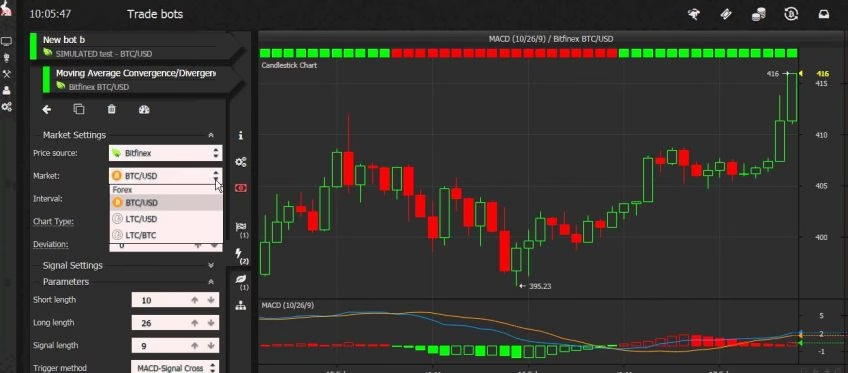Fundamental traders and technical traders are two different kinds of traders who deal with markets in their own methods. In automated trading systems, fundamental traders and technical traders may employ different technologies and techniques for data analysis. To make well-informed trading decisions the focus of fundamental traders is on economic and financial information. This includes interest rates, economic indicators and corporate earnings. They believe that changes in these fundamental elements drive market trends and that understanding the driving forces is vital to make well-informed trading decision. Technical traders tend to focus more on chart patterns and technical indicators to help them make their decisions in trading. Technical traders believe that past market behavior and trends can be used to forecast future market developments. They believe that technical analysis is more effective than analysis based on fundamentals. In the case of automated trading systems, traders who are fundamental may be more likely to use algorithms that incorporate the fundamentals of data and analysis in their decision-making process. Technical traders, however, might use algorithms that use charts and indicators that are technical to assist in their decision-making. The main differences between fundamental and technical traders are in how they approach markets and how they apply data and analytics to make trading decision-making. These differences can also result in differences in the types or automated trading platforms they employ. Technical trader tend to be more likely than fundamental traders to employ systems that incorporate fundamental analysis and data. Technical traders can also use systems that incorporate technical analysis. Follow the best divergence trading for more advice including trade indicators, backtesting trading strategies, backtesting, automated crypto trading, forex backtest software, trading with divergence, algo trading platform, free crypto trading bot, automated trading bot, crypto futures trading and more.

Automated Trading Systems - Simple Moving Averages And Exponential
Exponential Moving averages, or EMA, and Simple Moving Averages are both often used as technical indicators within automated trading systems. For example the 50-day SMA is calculated by summing up the prices at which a currency pair closed in the past 50 days and then dividing the result by 50.
The Exponential moving average (EMA), which is similar to SMA and gives greater weight to prices that are current in the calculation. The EMA is calculated using an unweighted sum of closing prices. This means that the weight given for the latest prices will be higher than the weight given for older prices. This means that the EMA responds quicker to changes in market conditions than the SMA.
Moving averages are commonly utilized in trading software that automates trades to detect trend and generate buy/sell signals. One strategy is to purchase when prices are over the moving mean and sell when they fall below it. Trends can be confirmed using moving averages. A rising moving average suggests an upward trend, whereas an average that falls indicates a downtrend.
In conclusion, EMA and SMA are two of the most commonly utilized technical indicators within automated trading systems, and can be used to identify patterns, generate signals for buying and selling, and to confirm trends. The needs and objectives of the trader will affect the choice of EMA or SMA. While the EMA is more flexible and responsive to changes in market conditions, the SMA is a more reliable indicator for longer-term trends. Read the best backtesting trading strategies for website examples including which platform is best for crypto trading, cryptocurrency trading bot, trading divergences, trading indicators, online trading platform, crypto futures, emotional trading, free trading bot, crypto trading backtesting, algorithmic trading software and more.

What Are Bollinger Bands? Automated Trading System?
Bollinger Bands are a scientific indicator that is commonly utilized for automated trading systems. They consist of three lines- a simple moving average (SMA) and two additional bands, which are plotted with by a specific number of standard deviations in relation to the SMA. The volatility of an asset determines the standard deviations used in computing the outer bands. Bollinger Bands can be used to identify changes in market conditions in automated trading systems. For example, when the price is outside the outer bands, it may indicate the possibility of a trend reversal, or a rise in volatility. However, if prices are within the outer bands it could indicate that the market is stabilizing and that a trend change may be less likely. Bollinger Bands can be used by traders along with momentum oscillators to generate buy signals to sell or buy. Some strategies involve buying when prices reach the lower Bollinger bands and selling once it is in higher Bollinger bands. Bollinger Bands are an important technical indicator for automated trading systems. They are used to detect the changes in market conditions and provide buying and selling signals. Bollinger Bands' usage or not will be contingent upon the goals and preferences of the trader, along with their style of trading and the approach they adopt. Read the most popular trading divergences for more recommendations including backtesting strategies, forex tester, auto crypto trading bot, backtesting platform, algo trading, backtesting strategies, stop loss in trading, algorithmic trading platform, rsi divergence, best cryptocurrency trading bot and more.

What Is Adx And Its Relationship To Obv (On-Balance Volume) And Regression
The Average Directional Index, or ADX is a type of technical indicator used in technical analyses to measure the strength the direction of a trend in financial market. It's used to assess the intensity of a trend. It calculates the difference between two exponentially moving Averages (EMAs) that are the high and low prices of an asset. ADX is often combined with other indicators, such as the +DI and -DI to generate buy/sell signals within automated trading systems. On-Balance Volume (OBV) which is a momentum indicator, uses the volume of changes to assess the strength of a trend. OBV and ADX both can be used to automate trading systems that provide signals to enter and leave positions. Both measures can measure different aspects of market activity and also provide complementary information. OBV, on the other hand, measures the selling and buying pressure. OBV tracks the cumulative quantity of buying and selling. ADX, for example can measure the strength of a trend. Regression, on the other hand, can be used to describe the relationship between dependent variables and one or several independent variables. In the trading world, regression analysis can be employed to examine the relationship between two or more variables for instance, volume and prices, or to identify patterns and trends in data.In conclusion, ADX, OBV and regression analysis are three different tools that can be used within automated trading systems that create signals, identify market trends and relationships, and make better trading decisions. The decision of which tool to employ will be based on the particular needs and goals of the trader, and the individual style of trading and approach to the market.